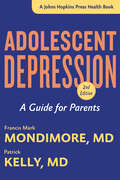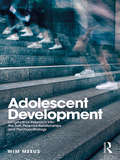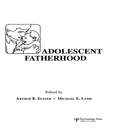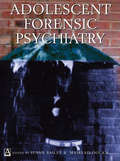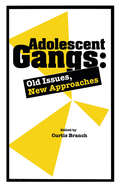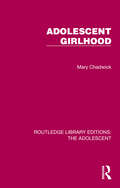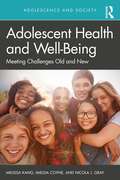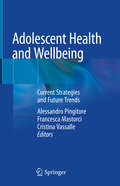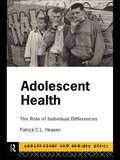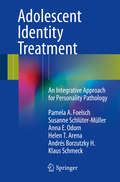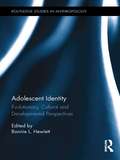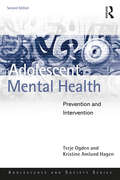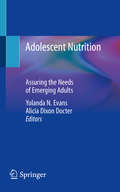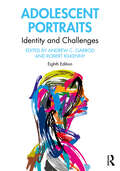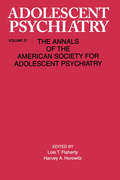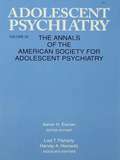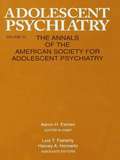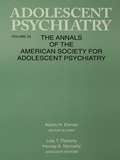- Table View
- List View
Adolescent Depression: A Guide for Parents (A Johns Hopkins Press Health Book)
by Patrick Kelly Francis Mark MondimoreThe timely second edition of this bestselling guide will inform and encourage struggling adolescents and their families.In Adolescent Depression, psychiatrists Francis Mark Mondimore, MD, and Patrick Kelly, MD, explain that serious depression in adolescents goes beyond "moodiness." Depression is in fact an illness—one that can be effectively treated. The authors describe the many forms of depression and the many symptoms of depression in young people—from sadness to irritability, self-harm, drug and alcohol abuse, and violent rages. Incorporating the latest research from the field of adolescent psychiatry, this comprehensive and compassionate guide answers questions that many parents have, including What are the symptoms of depression in teenagers? How is depression diagnosed? What is the difference between depression and bipolar disorder, and which does my child have? How can I find the best mental health professional team for my child? What kinds of counseling and psychotherapy are available? Are medications safe, and how does a doctor choose a medication for my child? What can I do if my adolescent is using alcohol, crystal meth, marijuana, or other substances? How do autism and Asperger's syndrome, eating disorders, premenstrual dysphoric disorder, ADHD, and disruptive mood dysregulation disorder interact with depression? What should I do if I sense that my child is in danger? With all of this going on, how can I take care of myself?
Adolescent Development: Longitudinal Research into the Self, Personal Relationships and Psychopathology
by Wim MeeusThis groundbreaking book provides students and researchers with a unique overview of the longitudinal study of the development of young people from the ages of 12 to 25. It offers a comprehensive introduction into the multiple theories on the development of the self, personal relationships and psychopathology in adolescence, alongside a non-statistical overview of the many longitudinal models used to study development. The book includes key topics such as the development of the self, adolescent identity and personality; the development of parent-adolescent relationships; friendships and the understanding of others; and the development of psychosocial problems such as anxiety, depression, delinquency, aggression, and substance use. Meeus highlights multiple findings showing how these processes are integrated and identifies eight fundamental patterns of adolescent development to help determine why most adolescents develop into mature and organized individuals towards the end of this life stage, whilst a substantial minority show an inability to mature. It is essential reading for graduate students and researchers in adolescent development and anyone seeking to use longitudinal research methodology in the social and behavioral sciences.
Adolescent Drinking and Family Life (Routledge Library Editions: The Adolescent)
by David Sibley Geoff Lowe David R. FoxcroftOriginally published in 1993, Adolescent Drinking and Family Life portrays teenage drinking, not as a symptom of pathology, but as a perfectly normal developmental phase within the context of the home environment. Drinking is predominantly social behaviour and the family is seen as a major agent of socialization. The authors have therefore explored family dynamics and the influence which the home environment has upon adolescent drinking to come up with a new theoretical model. A major feature of this approach is the interaction of ideas from family life psychology and human geography. The authors present a typology of domestic regimes illustrated by case studies of boundary enforcement and transgression. The general theme of boundary transgression, applied here to both the psychosocial environment and built form, represents an interesting new theoretical perspective. The integration of these two fields is an innovation which should stimulate further interdisciplinary work in adolescence and addiction research. Adolescent Drinking and Family Life will be interesting to researchers and practitioners in adolescence, family dynamics, and alcohol as well as any social scientist with an interest in the link between behaviour and the home environment. This new approach had important implications for health education and for interventions concerned with adolescent alcohol use at the time. Today it can be read in its historical context.
Adolescent Fatherhood
by ARTHUR B. ELSTER and MICHAEL E. LAMBFirst published in 1986. Routledge is an imprint of Taylor & Francis, an informa company.
Adolescent Forensic Psychiatry
by Susan Bailey Mairead DolanAdolescent Forensic Psychiatry discusses a broad range of issues based around the psychiatric needs of adolescents and how these relate to offending behaviour. Its well-structured approach looks at assessment, treatment and outcomes for different disorders and highlights the importance of effective interaction between specialist agencies. Services
Adolescent Gangs: Old Issues, New Approaches
by Curtis W. BranchPublished in 1998, Adolescent Gangs is a valuable contribution to the field of Counseling and School Therapy.
Adolescent Girlhood (Routledge Library Editions: The Adolescent)
by Mary ChadwickOriginally published in 1932, Adolescent Girlhood set out to give a general view of the more everyday problems a girl might encounter during adolescence. Both at home and at school and those problems that had, despite their prevalence, not gained as much attention or understanding as they merited or required. It was assumed that readers interested in development would have had some knowledge of the general concepts of psychology and psychoanalysis, given the prominence of discoveries in these fields over the previous ten to twenty years. <p><p> It starts with some history of the adolescent girl, including their representation in literature and goes on to cover issues such as physical changes, as well as psychological and emotional expectations. Today it can be read and enjoyed in its historical context. <p><p> This book is a reissue first published in 1932. The language used is a reflection of its era and no offence is meant by the Publishers to any reader by this re-publication.
Adolescent Gun Violence Prevention: Clinical and Public Health Solutions
by Nancy A. DodsonEach year, gun violence kills approximately 2,700 and injures approximately 14,500 children in the U.S.; the overwhelming majority of child gun deaths are among teenagers who die by homicide or suicide. Gun violence is the leading cause of death for Black teens. A recent spate of high-profile tragedies involving children, such as the Newtown mass shooting in 2012 and the Parkland mass shooting in 2018, have reinvigorated a national debate about the role of guns in our private and public spaces. Physicians, and in particular pediatricians, have become increasingly vocal about the need to address the epidemic of gun violence in the U.S.This book serves as an in-depth, comprehensive guide to adolescent gun violence prevention. It describes the epidemiology of teen gun violence in the U.S. by focusing on the parallel epidemics that claim the most lives: gun suicide among rural white males, and gun homicide among urban Black males. It offers in-depth reviews of key concepts that are crucial to reaching a meaningful understanding of gun violence. The text also addresses specific methods of intervention at various levels of society, from the individual; to the local community; and finally to the entire nation. This first of its kind book is a valuable reference for physicians, public health scientists, policy-makers, gun reform advocates, and anyone interested in working towards a safer future for young people.
Adolescent Health and Well-Being: Meeting Challenges Old and New (Adolescence and Society)
by Imelda Coyne Melissa Kang Nicola J GrayThis important book explores adolescent health and well-being through an ecological and developmental lens, drawing on international comparative studies and data sources to provide valuable contextual insights.Recognising that children and adolescents are not a homogenous group, this book highlights the importance of age distinctions in shaping health needs, risks, and protective behaviours. Adolescent development, the epidemiology and social determinants of adolescent health, health literacy and health promotion are foundational themes woven throughout the chapters. It explores how gender influences both health behaviors and outcomes, emphasising the need for a nuanced understanding of adolescent well-being. By presenting data comparisons across time and socio-demographic groups, this book sheds light on disparities related to gender, ethnicity (including Black and minority ethnic and Indigenous populations), age, geography, and socioeconomic status, offering valuable insights into the diverse factors that shape adolescent health.This textbook is intended for clinicians, researchers, policymakers, advocates, youth workers, adolescents and their parents and carers.
Adolescent Health and Wellbeing: Current Strategies and Future Trends
by Alessandro Pingitore Francesca Mastorci Cristina VassalleThis book presents a detailed and updated review of the widespread changes that take place during adolescence, adopting a preventive perspective that reflects physical, social, cognitive, and emotional changes. It addresses a broad range of aspects, including: the preventive programs and their systemic effects; the role of environment in influencing the healthy behaviors of adolescents and young adults; the use of e-Health technology in health and behavioral interventions for adolescents; and the clinical and prognostic implications of primordial prevention in healthy adolescents. All of these elements are subsequently reviewed using a multidimensional approach, in order to offer extensive information on the complex changes that characterize adolescents’ physiological, psychological, and neurobiological development.In addition, the book depicts the preventive strategies currently used in various social settings (school, family, sport club, health policies) aimed not only at reducing lifestyle risk behaviors, but also at improving resilience, happiness, social involvement, self-esteem, and sociability. This update is essential in the light of the fact that, to date, prevention has mainly been directed towards adolescents with physical or mental disorders rather than their healthy peers. As such, the book offers a valuable tool for pediatricians, child and adolescents psychiatrists, and for all professionals involved in Health Promotion and Disease Prevention.
Adolescent Health: The Role of Individual Differences (Adolescence and Society)
by Patrick HeavenAdolescence is one of the most turbulent yet exciting phases in life. Increased autonomy brings with it new health risks ranging from drugs and sexually transmitted disease, to eating disorders and suicidal depression. Even though todays teenagers are more concerned with and educated about their health than any previous generation, they still engage in risky behaviour. Adolescent Health explores how individual differences contribute to health and illness across a wide range of cultures and socio-economic backgrounds. Patrick Heaven blends the latest research findings from a range of sources with practical suggestions on how to improve health care services for adolescents. Adolescent Health will prove valuable to professionals working with young people, social science students and parents.
Adolescent Identity Treatment: An Integrative Approach for Personality Pathology
by Pamela A. Foelsch Susanne Schlüter-Müller Anna E. Odom Klaus Schmeck Helen T. Arena Andrés H. BorzutzkyAdolescent Identity Treatment: An Integrative Approach for Personality Pathology is a ground breaking title that provides general and specific clinical strategies to help adolescents who lack an integrated identity. The authors have developed a treatment based on the integration of object relations theory, family systems, attachment, developmental neurobiology and cognitive behavioral approaches that focuses on clearing blockages to normal identity development and adaptive functioning. While most adolescents build satisfying interpersonal relationships, are successful in school and work and begin romantic relationships, there is a minority of adolescents who do not succeed in this and are at a high risk of developing problems in school, work and relationships, problems with affect regulation as well as engaging in a wide range of self-destructive behaviors. In addition to a description of the disorder and assessment, this manual offers extensive clinical examples and concrete interventions, with phase-specific treatment components, including a clear treatment frame, psychoeducation, environmental interventions (with a "Home Plan" that addresses self-care behaviors, responsibilities and improved boundaries that fosters the development of better relationships between the adolescent and family) and parenting strategies, all in the service of creating a space for the individual work with the adolescent.
Adolescent Identity: Evolutionary, Cultural and Developmental Perspectives (Routledge Studies in Anthropology #7)
by Bonnie L. HewlettAs our world becomes increasingly permeable, and as human populations are rapidly converging and transitioning within a global interconnectedness, it is vital that we look to, and learn from, those most adept at the adaptation, creation, and contesting of culture: adolescents. This text is designed to bridge critical gaps in the understanding of the daily lives, identity development, and experiences of adolescents in diverse cultures around the world. Cultural context is predictive of developmental uniqueness; comparisons provide insights into how social structures and relationships influence the manifestation of individual patterns of development and experience. In quantitative and qualitative detail, the contributors relate the nature of adolescent life to cultural, biological, ecological, demographic, and social variables. The findings of this book will be relevant not only to other social anthropologists, but also to sociologists and developmental/educational psychologists.
Adolescent Mental Health: Prevention and Intervention (Adolescence and Society)
by Terje Ogden Kristine Amlund HagenAdolescence is a period characterized by both increased susceptibility to risks and new-found strength to withstand them. Whilst most young people are well equipped to manage the changes associated with growing up, other maladjusted and marginalized adolescents already have, or are at risk of developing, mental health problems. Adolescent Mental Health: Prevention and Intervention is a concise and accessible overview of our current knowledge on effective treatment and prevention programs for young people with mental health problems. Whilst addressing some of the most common mental health issues among young people, such as behavioral problems and drug-related difficulties, it also offers a fuller understanding of the evidence-based treatment and prevention programs that are built upon what we know about how these behavioral and emotional problems develop and are sustained. The volume illustrates contemporary and empirically supported interventions and prevention efforts through a series of case studies. It has been fully updated in line with the latest NICE and DSM-V guidelines, and now includes an added chapter on implementation, and what factors facilitate implementation processes of intervention efforts. Adolescent Mental Health: Prevention and Intervention will be essential reading for students and practitioners in the fields of child welfare and mental health services, and any professional working with adolescents at risk of developing mental health problems.
Adolescent Nutrition: Assuring the Needs of Emerging Adults
by Yolanda N. Evans Alicia Dixon DocterAdolescents have unique nutritional needs when compared to young children and adults. As youth go through physical, cognitive, and behavioral development, nutrition needs are dynamic and changing. If these needs go undetected and remain unaddressed, the results can derail physical and social maturation and include life-long effects on health. This comprehensive text offers a multidisciplinary perspective on aspects of adolescent nutrition. Using clinical cases, it covers relevant topics related to adolescent health including normal development, chronic health conditions, and complex biopsychosocial dynamics, among others. The first section of the text contains an overview of adolescent nutrition that is further broken down into more specific topics such as developmental nutrition needs, needs of active youth and athletes and media influences on body image. The next section focuses on health disparities such as culturally appropriate care, health equity, international considerations and food insecurity. The following section specifically addresses eating disorders ranging from anorexia and bulimia to binge eating. Finally, the last section covers additional health considerations such as polycystic ovarian syndrome, teen pregnancy, substance use and gender non-conforming youth. Written by experts in the field, this book is a helpful resource for primary care medical providers, registered dietitians/nutritionists (RDN), adolescent medicine specialists, as well as advanced practice nurses, physician assistants, psychologists, licensed social workers, and certified athletic trainers.
Adolescent Portraits: Identity and Challenges
by Andrew C. GarrodAdolescent Portraits introduces contemporary theories and research that surround adolescent development today through eighteen first-person accounts written by young adults. The case study approach of the book illustrates the complexity of the individual experience and the interactions among an individual’s needs, ideas, relationships, and context. Each case, taken alone, helps us begin to know one more adolescent and his or her experience; taken together, the cases provide a rich overview of the wide, diverse, and complex range of adolescent experiences. This edition also includes three follow-up essays, written five or more years after their original memoir. The authors of these follow-ups reflect on their original story written in late adolescence from the more mature point of view of full-fledged adulthood. These retrospectives provide a poignant and lifespan developmental perspective on the ways in which the adolescent themes of identity and challenges transform, for better or worse, with the tasks of adulthood. With contributions from adolescents from a range of racial, class, and family backgrounds, the book provides a diverse introduction to the adolescent experience. It is a must-read for any student of adolescent development.
Adolescent Pregnancy and Parenting: Findings From A Racially Diverse Sample (Research Monographs in Adolescence Series)
by Patricia L. East Marianne E. FeliceWritten by a pediatrician/adolescent medicine specialist and a developmental psychologist, this book is a collection of informative, nonredundant yet comprehensive studies on adolescent pregnancy and parenting. More than 200 adolescent women in an ethnically diverse sample were studied prenatally and at regular 6-month intervals for 3½ years postpartum. Most of the teens were poor, unmarried, first-time mothers who resided within Southeast San Diego, a poor urban area approximately 10 miles north of the U.S.-Mexico border. The purpose of this book was to offer researchers, practitioners, program directors, teachers, and graduate and medical students a better understanding of teenage pregnancy and parenthood within the following domains: * adolescent prenatal care and postpartum maternal and infant health outcomes, * immediate repeat pregnancy, * adolescent mothers' parenting, * the role of the adolescent's mother in teenage mothers' parenting, and * the baby's father.
Adolescent Pregnancy and Parenting: Reducing Stigma and Improving Outcomes
by Lois T. Flaherty Jean-Victor P. Wittenberg Daniel F. BeckerThis book focuses on the impact of social stigma on adolescents who are at high risk of teen pregnancy. It describes and discusses personal and social factors that predispose them to becoming pregnant and having babies; factors that may subsequently protect or more often, compromise outcomes for both parents and children. The authors, who represent a range of social roles and perspectives, describe the pathways from stigma and its unfounded beliefs about disadvantaged adolescents, to the ways stress burdens teen parents and their children. They note that successful teen parents often go unrecognized and wonder how many more are hobbled by stigma. They recognize the lifespan impacts of stress as described in the ACE studies; stress that has psychological, health and economic implications at individual and social levels. They examine the impact of stigma on parent-child relationships and the attachment system, a stress management system, learned in infancy and persisting into adulthood. The book describes how stigma finds its way into daily interpersonal encounters, systemic policies and practices, and even into healthcare research and services.This sets the stage for an in-depth look at attachment systems within stress management, interventions, and recommendations for professionals whose work is impacted by these issues. Written by experts in the field, this text is the first to cover the current understanding of the risk factors, advanced understanding of developmental issues, and the key intervention tactics for the most positive outcome for adolescent parents and their families.Adolescent Pregnancy and Parenting is an excellent resource for psychiatrists, psychologists, physicians, social workers, educators, researchers, and policy makers working with youths at risk for teenage pregnancies.
Adolescent Psychiatry, V. 20: Annals of the American Society for Adolescent Psychiatry (Adolescent Psychiatry Ser. #Vol. 12)
by Richard C. Marohn Sherman C. FeinsteinLaunched in 1971, Adolescent Psychiatry, in the words of founding coeditors Sherman C. Feinstein, Peter L. Giovacchini, and Arthur A. Miller, promised "to explore adolescence as a process...to enter challenging and exciting areas that may have profound effects on our basic concepts." Further, they promised "a series that will provide a forum for the expression of ideas and problems that plague and excite so many of us working in this enigmatic but fascinating field." For over two decades, Adolescent Psychiatry has fulfilled this promise. The repository of a wealth of original studies by preeminent clinicians, developmental researchers, and social scientists specializing in this stage of life, the series has become an essential resource for all mental health professionals working with youth. Volume 20 of the series serves as a tribute to editor emeritus Sherman C. Feinstein. In addition to an appreciation of, and contributions by, Dr. Feinstein, it contains heretofore unpublished papers by two other major figures in adolescent psychiatry, founding father William Schonfeld and a Viennese colleague transplanted to America, Siegfried Bernfeld. With sections on general considerations of adolescence, specific syndromes, and treatment modalities, volume 20 presents the work of many of today's preeminent minds in adolescent psychiatry.
Adolescent Psychiatry, V. 21: Annals of the American Society for Adolescent Psychiatry
by Lois T. Flaherty Harvey A. HorowitzLaunched in 1971, Adolescent Psychiatry, in the words of founding coeditors Sherman C. Feinstein, Peter L. Giovacchini, and Arthur A. Miller, promised "to explore adolescence as a process . . . to enter challenging and exciting areas that may have profound effects on our basic concepts." Further, they promised a "series that will provide a forum for the expression of ideas and problems that plague and excite so many of us working in this enigmatic but fascinating field." For over two decades, Adolescent Psychiatry has fulfilled this promise. The repository of a wealth of original studies by preeminent clinicians, developmental researchers, and social scientists specializing in this stage of life, the series has become an essential resource for all mental health practitioners working with youth. Volume 21 honors the memory of Richard C. Marohn, former editor of Adolescent Psychiatry, and Herman D. Staples, founding member of the American Society for Adolescent Psychiatry. It begins with a section of papers that ranges over important aspects of "Development and Psychopathology." Topics explored by the contributors include: adolescents and authority; adolescents and disaster; adolescent awareness of the past; adolescent daughters of divorce; parent loss; adolescent schizophrenia; and adolescent mood disorders. Sections on "Assessment," "Issues in Psychotherapy," and "Training" round out a balanced survey of the field that is true to the spirit of this distinguished series. Volume 21 will be rewarding reading for child and adolescent therapists and all students of early development.
Adolescent Psychiatry, V. 22: Annals of the American Society for Adolescent Psychiatry (Adolescent Psychiatry Ser. #Vol. 12)
by Lois T. Flaherty Aaron H. Esman Harvey A. HorowitzLaunched in 1971, Adolescent Psychiatry, in the words of founding coeditors Sherman C. Feinstein, Peter L. Giovacchinni, and Arthur A. Miller, promised "to explore adolescence as a process . . . to enter challenging and exciting areas that may have profound effects on our basic concepts." Further, they promised "a series that will provide a forum for the expression of ideas and problems that plague and excite so many of us working in this enigmatic but fascinating field." For over two decades, Adolescent Psychiatry has fulfilled this promise. The repository of a wealth of original studies by preeminent clinicians, developmental researchers, and social scientists specializing in this stage of life, the series has become an essential resource for all mental health practitioners working with youth. With volume 22, the editorship of Adolescent Psychiatry passes to Aaron E. Esman, a distinguished clinician and educator whose wide-ranging sensibilities gain expression in a collection rich in clinical, developmental, and scholarly insight. Encompassing developmental topics (adolescent daydreams) timely clinical issues (eating disorders, impulse control disorders, narcissistic and antisocial pathology), historical commentaries (Shakespeare's adolescents, Nietzsche's romantic construction of adolescence, Freud's Dora as an adolescent), and a special section on "ambient genocide and adolescence," volume 22 ably meets the needs of professional and scholarly readers interested in this vitally important stage of life.
Adolescent Psychiatry, V. 23: Annals of the American Society for Adolescent Psychiatry (Adolescent Psychiatry Ser. #Vol. 12)
by Lois T. Flaherty Aaron H. Esman Harvey A. HorowitzLaunched in 1971, Adolescent Psychiatry, in the words of founding coeditors Sherman C. Feinstein, Peter L. Giovacchinni, and Arthur A. Miller, promised "to explore adolescence as a process . . . to enter challenging and exciting areas that may have profound effects on our basic concepts." Further, they promised "a series that will provide a forum for the expression of ideas and problems that plague and excite so many of us working in this enigmatic but fascinating field." For over two decades, Adolescent Psychiatry has fulfilled this promise. The repository of a wealth of original studies by preeminent clinicians, developmental researchers, and social scientists specializing in this stage of life, the series has become an essential resource for all mental health practitioners working with youth. Volume 23 of The Annals begins with the late Richard Marohn's reexamination of Peter Blos's concept of "prolonged adolescence," followed by contributions on the developmental roots of adolescent disturbances, the role of family interactions in adolescent depression, the establishment of a therapeutic alliance with adolescents, and the treatment of narcissistically disordered adolescents. The assessment and treatment of adolescent substance abuse and of psychosomatic and depressive symptoms in adolescence receive timely consideration. In a concluding section on "School-Based and Preventive Programs," contributors address a range of important issues, from adolescent sex and AIDS, to the provision of mental health services in public and private schools, to the need for school-based suicide postvention programs. In summary, volume 23 shows adolescent psychiatry to be as vital as ever, building on the clinical wisdom of the past while responding to the urgent challenges of the day.
Adolescent Psychiatry, V. 24: Annals of the American Society for Adolescent Psychiatry (Adolescent Psychiatry Ser. #Vol. 12)
by Lois T. Flaherty Aaron H. Esman Harvey A. HorowitzLaunched in 1971, Adolescent Psychiatry promised "to explore adolescence as a process . . . to enter challenging and exciting areas that may have profound effects on our basic concepts." Further, they promised "a series that will provide a forum for the expression of ideas and problems that plague and excite so many of us working in this enigmatic but fascinating field." The repository of a wealth of original studies by preeminent clinicians, developmental researchers, and social scientists specializing in this stage of life, the series has become an essential resource for all mental health practitioners working with youth. Volume 24 of The Annals surveys four broad areas of adolescent psychiatry that speak to the challenges and opportunities now before the field. Part I offers three important reassessments of adolescent development; they focus, respectively, on separation-individuation theory, the interpersonal matrix of adolescence, and the psychology of belonging. Part II explores the future of child and adolescent psychiatry in the context of school-based mental health services. Several assessments of ongoing school-based mental health clinics provide the context for reflection on the future of school-based delivery systems. Part III examines forensic issues in adolescent psychiatry and includes an overview of forensic psychiatry for adolescent psychiatrists, an update on juvenile justice, and a review of the issue of competence in adolescents. Finally, Part IV offers a series of current perspectives on psychopharmacology in relation to adolescence. Contributors review the current status of pharmacological treatment of different adolescent populations, including adolescents with behavior disorders, affective disorders, anxiety disorders, pervasive developmental disorders, and psychosis. The volume concludes with a timely examination of the role of psychiatric consultation on an adolescent medical service.
Adolescent Psychiatry, V. 25: Annals of the American Society for Adolescent Psychiatry
by Lois T. Flaherty Aaron H. Esman Harvey A. HorowitzVolume 25 of The Annals is a timely reprise on developmental, psychotherapeutic, and forensic issues that enter into the evaluation and treatment of adolescents. It traverses different explanatory perspectives, offers integrative expositions of several treatment modalities, and wrestles with the legal dimensions of adolescent care.The volume begins with three developmental studies: Shelley Doctors's clinically grounded reconsideration of "adolescent turmoil," Charles Jaffe's dynamic systems approach to adolescent psychotherapy, and Saul Levin's thoughtful consideration of four aspects of the adolescent passage that clinicians tend to ignore: the adolescent's sense of being, of belonging, of believing, and of benevolence. A thorough review of adolescent personality pathology and a case report of adolescent mourning are followed by a series of papers exploring three principal treatment modalities commonly employed in work with disturbed adolescents: psychodynamic, interpersonal, and the integrated approach of the Austen Riggs Center. Consideration of the game of chess as a "method and metaphor" for working with object relationships in narcissistic teenagers concludes the section of material on therapeutic approaches. The final section of volume 25 engages two knotty forensic issues that have come to the fore in adolescent psychiatry. Saul Levin examines the legal and developmental dimensions of the informed consent of minors whereas Everett Dulit outlines three clinical constellations associated with female adolescents' denial of pregnancy and examines their relationship to neonaticide.Like its distinguished predecessors, volume 25 is a thoughtfully assembled collection that not only spans the many facets of adolescent psychiatry but is responsive to the most pressing challenges - evaluative, therapeutic, legal - before the field.
Adolescent Psychiatry, V. 26: Annals of the American Society for Adolescent Psychiatry
by Lois T. FlahertyVolume 26 of The Annals begins with essays that address the challenge of maintaining human connections in a biological century; Philip Katz focuses on the human encounter between therapist and patient whereas Vivian Rakoff emphasizes the continuing identity of the healer throughout history. Papers on adolescent development, which challenge readers to look beyond preconceived ideas, include Robert Galatzer-Levy's examination of adolescence as a social construction expressed in contradictory cultural narratives and Jack Drescher's exploration of the developmental narratives of gay men in order to illuminate the seeming invisibility of gay adolescents. A section dedicated to "Trauma, Violence, and Suicide" explores interventions with special groups of high-risk adolescents, including violent offendors, suicide attempters, and adolescent refugees. A special section on attention deficit/hyperactivity disorder and conduct disorders includes a debate on whether or not conduct disorder is actually a valid diagnosis. The final section of Volume 26 addresses social issues of continuing relevance to adolescent psychiatry: the juvenile death penalty and gays in the military. Reprinted here are the ASAP's position statements on these two issues along with its amici curiae brief in support of the petitioner in the landmark Supreme Court case of Thompson v. Oklahoma. Volume 26 of The Annals tracks the continuing evolution of adolescent psychiatry as it strives to keep pace with therapeutic and social responsibilities which, in the 21st century, have become increasingly intertwined. We have here a typically thoughtful compendium that, in drawing attention to the pressing issues before those who work with adolescents, highlights bith the field's achievements to date and the work that lies before it.
